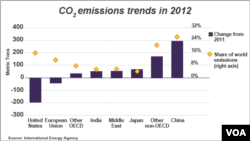LONDON —
China led a rise in global carbon dioxide emissions to a record high in 2012, more than offsetting falls in the United States and Europe, the International Energy Agency (IEA) said on Monday.
Worldwide CO2 emissions rose by 1.4 percent to 31.6 billion tons, according to estimates from the Paris-based IEA.
China is the biggest emitter and made the largest contribution to the global rise, spewing out an additional 300 million tons. But the gain was one of the lowest China has seen in a decade, reflecting its efforts to adopt renewable sources and improve energy efficiency.
In the United States, a switch from coal to gas in power generation helped reduce emissions by 200 million tons, bringing them back to the level of the mid-1990s.
Even though the use of coal increased in some European countries last year due to low prices, emissions in Europe declined by 50 million tons because of the economic slowdown, growth in renewables, and emissions caps on industrial and power companies, the IEA said.
Japan's CO2 emissions increased by 70 million tons, as efforts to improve energy efficiency failed to offset increasing use of fossil fuels after the Fukushima nuclear accident in 2011.
Temperature rises
Scientists say global average temperature rise needs to be limited to below 2 degrees Celsius this century to prevent devastating climate effects like crop failure and melting glaciers.
That would only be possible if emission levels are kept to around 44 billion tons of CO2 equivalent by 2020.
However, the IEA said the data shows the world is on a path to an average temperature rise of between 3.6 and 5.3 degrees Celsius.
“Global energy-related greenhouse gas emissions in 2020 are projected to be nearly 4 billion tons higher than a level consistent with attaining the 2 degree target, highlighting the scale of the challenge still to be tackled just in this decade,” the agency said.
The IEA urged governments to quickly adopt four policies that would ensure climate goals could be reached without harming economic growth. They are: improving energy efficiency in buildings, industry and transport; limiting the construction and use of inefficient power plants; halving methane emissions; and partially phasing out fossil fuel subsidies.
These would reduce global energy-related emissions by 8 percent or 3.1 billion tons of CO2 equivalent in 2020, the IEA said.
“Delaying stronger climate action to 2020 would come at a cost: $1.5 trillion in low-carbon investments are avoided before 2020, but $5 trillion in additional investments would be required thereafter to get back on track,” the IEA said.
International negotiators are meeting in Bonn, Germany, until Friday for U.N. talks aimed at getting a new global climate treaty, which would cut emissions, signed by 2015.
However, the talks got off to a slow start last week due to attempts by three nations to amend one of the meeting's many agendas to discuss how future decisions should be made.
Worldwide CO2 emissions rose by 1.4 percent to 31.6 billion tons, according to estimates from the Paris-based IEA.
China is the biggest emitter and made the largest contribution to the global rise, spewing out an additional 300 million tons. But the gain was one of the lowest China has seen in a decade, reflecting its efforts to adopt renewable sources and improve energy efficiency.
In the United States, a switch from coal to gas in power generation helped reduce emissions by 200 million tons, bringing them back to the level of the mid-1990s.
Even though the use of coal increased in some European countries last year due to low prices, emissions in Europe declined by 50 million tons because of the economic slowdown, growth in renewables, and emissions caps on industrial and power companies, the IEA said.
Japan's CO2 emissions increased by 70 million tons, as efforts to improve energy efficiency failed to offset increasing use of fossil fuels after the Fukushima nuclear accident in 2011.
Temperature rises
Scientists say global average temperature rise needs to be limited to below 2 degrees Celsius this century to prevent devastating climate effects like crop failure and melting glaciers.
That would only be possible if emission levels are kept to around 44 billion tons of CO2 equivalent by 2020.
However, the IEA said the data shows the world is on a path to an average temperature rise of between 3.6 and 5.3 degrees Celsius.
“Global energy-related greenhouse gas emissions in 2020 are projected to be nearly 4 billion tons higher than a level consistent with attaining the 2 degree target, highlighting the scale of the challenge still to be tackled just in this decade,” the agency said.
The IEA urged governments to quickly adopt four policies that would ensure climate goals could be reached without harming economic growth. They are: improving energy efficiency in buildings, industry and transport; limiting the construction and use of inefficient power plants; halving methane emissions; and partially phasing out fossil fuel subsidies.
These would reduce global energy-related emissions by 8 percent or 3.1 billion tons of CO2 equivalent in 2020, the IEA said.
“Delaying stronger climate action to 2020 would come at a cost: $1.5 trillion in low-carbon investments are avoided before 2020, but $5 trillion in additional investments would be required thereafter to get back on track,” the IEA said.
International negotiators are meeting in Bonn, Germany, until Friday for U.N. talks aimed at getting a new global climate treaty, which would cut emissions, signed by 2015.
However, the talks got off to a slow start last week due to attempts by three nations to amend one of the meeting's many agendas to discuss how future decisions should be made.









